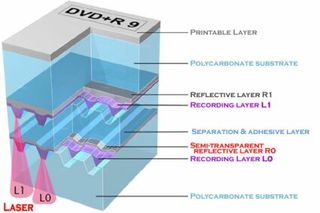Double-Layer DVD: Lite-On, LG and BenQ
How Does It Work?
In the case of a double-layer recordable DVD, the successive layers are slightly different:

The main problem lay in finding an intermediate R0 reflective layer (in red on the diagram) that would be transparent enough to allow the laser beam to pass through to the second layer L1, but reflective enough to enable the information contained on layer L0 to be readable. In order to be compatible with the standard double-layer DVD-ROM (or DVD Video) the reflective layers (R0 and R1) needed to have a reflective power of at least 18%. Again, in order to remain within the DVD standard, the R0 layer had to transmit at least 50% of the laser beam (for playing and recording). This meant that there was a very narrow margin to work with. To achieve the result, the R0 consists of a silver alloy and the shape of the recording pits has been optimized. The separation layer is only 55 µm thick and serves to physically separate the two layers.
When playing and burning, the laser beam can easily be concentrated on either of the two layers by adjusting the lens focus.
Just as for playing double-layer DVD video, recording in DL mode follows the diagram above. Burning starts in the center of the DVD on the first layer and when it reaches the outer edge of the DVD the lens viewfinder changes focus to allow the laser to reach the second layer. Burning starts again from the outside of the disc toward the center.
Using this technology, it is theoretically possible to store 8.5 GB on a single disc. In practice, you can store exactly 7.96 GB. In video mode, you can record four hours in DVD quality and up to 16 hours in VHS quality. On the other hand, when you switch to this mode, the speed drops to 2.4x.
16x: The Final Destination?
Although marginal to double-layer technology, manufacturers have not slowed down their quest for greater speed. As usual, it's the "+" format that leads the field. The maximum speed obtained is 16x in +R. In -R it remains at 8x while in rewritable it is only 4x for DVD-RW and DVD+RW.
Everyone agrees that with 16x the top speed has been reached. At this speed, the disc spins at around 10,000 rpm and the burner reaches its physical limitations. There are more sophisticated mechanical systems around that could stabilize the DVD and reduce vibrations, but incorporating them would seriously increase production costs. The price of the final product would be way above what the market will bear.
Stay on the Cutting Edge
Join the experts who read Tom's Hardware for the inside track on enthusiast PC tech news — and have for over 25 years. We'll send breaking news and in-depth reviews of CPUs, GPUs, AI, maker hardware and more straight to your inbox.
Current page: How Does It Work?
Prev Page Double-layer: The Latest Technology Next Page BenQ DW-1600AMost Popular

